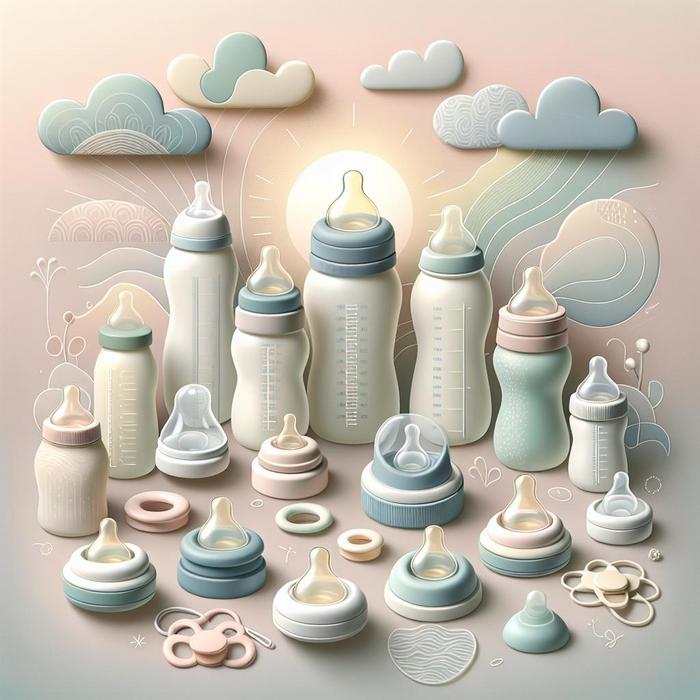The Importance of Choosing the Right Bottle Nipple
The process of selecting the right bottle nipple for your little one is an essential task that requires thoughtful consideration. But why is it such a critical factor in your baby’s feeding routine? Let’s delve into that.
Why the Right Bottle Nipple Matters
Primarily, the correct nipple for your baby’s bottle ensures a healthy and comfortable feeding experience. A perfectly chosen nipple can help prevent unwanted air ingestion, which can lead to colic, gas, and other discomforts. Additionally, the transition from breast to bottle becomes smoother when your baby becomes accustomed to an appropriate bottle nipple at an early stage.
Most importantly, a breastfeeding and bottle-feeding balance can be achieved by selecting the best bottle nipple that mirrors the nursing mother’s feel and flow.
Parameters for Selecting the Correct Nipple
There are several factors to consider while choosing the right nipple for your baby’s bottle:
- The age and developmental stage of the baby
- The flow rate that best suits the baby’s feeding pace
- The material of the nipple, considering its durability, cleanliness, and the baby’s potential allergies
- The shape of the nipple that best matches the mother’s
These parameters help ensure that your baby has a happy and healthy feeding experience.
How to Know You’ve Chosen the Correct Nipple?
An accurate way to know if you’ve chosen the best bottle nipple is by observing your baby’s response during feeding. Some signs of right nipple selection include:
- Your baby feeds comfortably without fussing or pulling away
- The baby does not choke or show signs of discomfort during feeding
- Your baby completes a feeding within a suitable time frame (usually around 20 minutes)
- No leakage occurs around the baby’s mouth
If you notice any of the negative signs, it might be time to reevaluate your choice and select a different nipple type or nipple flow.
Links to Detailed Guides
Deciding on the right bottle nipple can be confusing due to the variety of choices in the market. Detailed guides such as the nipple level guide by Dr. Brown’s and the baby bottle nipples guide by Philips can help you make informed decisions.
Furthermore, these guides from Parents.com and Similac are great resources for understanding bottle nipple sizes and the impact of various sizes on your baby’s feeding experience.
Making the Transition Smooth
Once you’ve chosen the correct nipple, the next step is ensuring a smooth bottle feeding transition. It is best to introduce bottle feeding gradually to avoid overwhelming your baby. Implementing the tips from our guide on smooth bottle feeding transition can make this process easier.
Considering Different Bottle Nipple Types
When starting your search, it’s worth noting that not all bottle nipples are the same. They come in different shapes, materials, and flow rates; each offers unique attributes cater to different baby needs. Hence, identifying your baby’s specific needs is the first step in choosing the right bottle nipple.
- Nipple Material: Silicone and latex are the two main materials used. Silicone is clear, durable, and less likely to cause allergic reactions. Latex nipples, on the other hand, are softer but may need more frequent replacement due to wear.
- Nipple Flow: Nipples come in varying flow rates. Newborns require slow-flowing nipples, while older babies can handle medium or even fast flow nipples. How to choose the best bottle flow rate can provide comprehensive information on this matter.
- Nipple Shape: Traditional and orthodontic are the usual shapes. Traditional nipples mimic the shape of a woman’s breast while breastfeeding. Orthodontic nipples, designed to protect the baby’s palate and gums, have a bulb that fits into the mouth’s roof.
Achieving the Ideal Breast-Bottle Balance
For mothers who wish to maintain both breastfeeding and bottle feeding, finding the right bottle nipple can help achieve that balance. One strategy is to find a nipple that closely mimics the feel and flow of a mother’s breast. This similarity can help the baby transition seamlessly between bottle and breast. A helpful read on this topic would be Finding the Right Bottle Nipple for your Breastfeeding Baby.
Caring for Your Baby’s Bottle Nipples
Once you’ve chosen the right bottle nipple, proper care and maintenance are crucial to ensure its longevity and performance. Nipples should be replaced every 3-4 months or at the first sign of wear and tear. For how to take care of baby bottles and nipples, this comprehensive guide can be beneficial.
Wrapping Up
In conclusion, choosing the right bottle nipple is a crucial decision that significantly influences your baby’s feeding experience. Although it can seem overwhelming given the vast number of options available, remember that every baby is different. Start with a basic type and adjust according to your baby’s needs and comfort. Once you’ve found the right bottle nipple, ensure proper maintenance for an optimum feeding experience.
Hopefully, this guide sheds some light on the significance of this choice and helps you make an informed decision. Browse additional resources like this guide from Happy Family Organics for a deeper understanding.
In the end, the right bottle nipple should offer your baby a comfortable, healthy, and satisfying feed.

